|
|
McDonnell Douglas (commercial)
McDonnell Douglas was a major American aerospace manufacturing corporation and defense contractor formed by the merger of McDonnell Aircraft and the Douglas Aircraft Company in 1967. The corporation was based at Lambert-St. Louis International Airport near St. Louis, Missouri. Between then and its own merger with Boeing in 1997, it produced a number of well-known commercial and military aircraft such as the DC-10 airliner and F-15 Eagle air-superiority fighter.
DC-8 | DC-9 | DC-10 |
MD-11 | MD-80 |
MD-82 | MD-83 |
MD-87 | MD-90
McDonnell Douglas DC-8
The McDonnell Douglas DC-8 (developed as the Douglas DC-8 by Douglas Aircraft) is a four-engine long-range narrow-body jet airliner built from 1958 to 1972. Launched after the competing Boeing 707, the DC-8 nevertheless kept Douglas in a strong position in the airliner market, and remained in production until 1972 when it began to be superseded by larger wide-body designs, including the Boeing 747, McDonnell Douglas DC-10 and Lockheed L-1011 TriStar. The DC-8's design allowed it a slightly larger cargo capacity than the 707 and some re-engined DC-8s are still in use as freighters.

McDonnell Douglas DC-8-63, registration PH-DEC, built 1968, serial number 45999
Schiphol (AMS), Amsterdam, Netherlands, 2 April 1983

McDonnell Douglas DC-8-63, registration PH-DEM, built 1970, serial number 46141
Schiphol (AMS), Amsterdam, Netherlands, 24 November 1976
DC-8 | DC-9 | DC-10 |
MD-11 | MD-80 |
MD-82 | MD-83 |
MD-87 | MD-90
McDonnell Douglas DC-9
The McDonnell Douglas DC-9 was developed by Douglas Aircraft and launched as Douglas DC-9 in 1963. It was a short-range companion to their larger four engined DC-8 in 1963. The DC-9 was an all-new design, using two rear fuselage-mounted Pratt & Whitney JT8D turbofan engines, a small, efficient wing and a T-tail. It was first manufactured in 1965 with its maiden flight later that year. The DC-9 was designed for frequent, short flights. Production ended in October 1982.
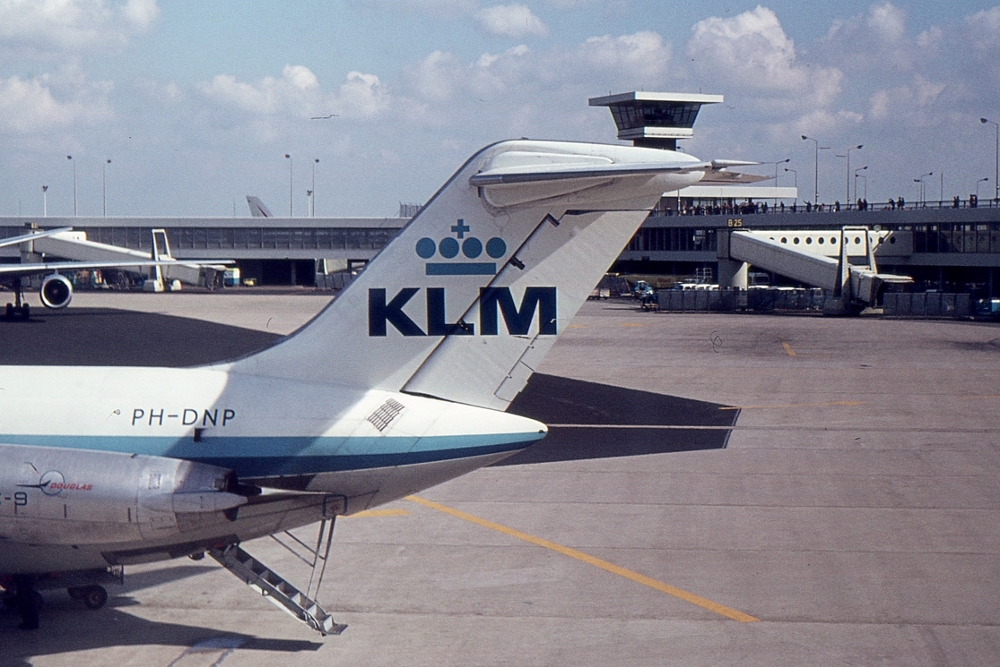
McDonnell Douglas DC-9-33F, registration PH-DNP, built 1968, serial number 47194
Schiphol (AMS), Amsterdam, Netherlands, 10 September 1974
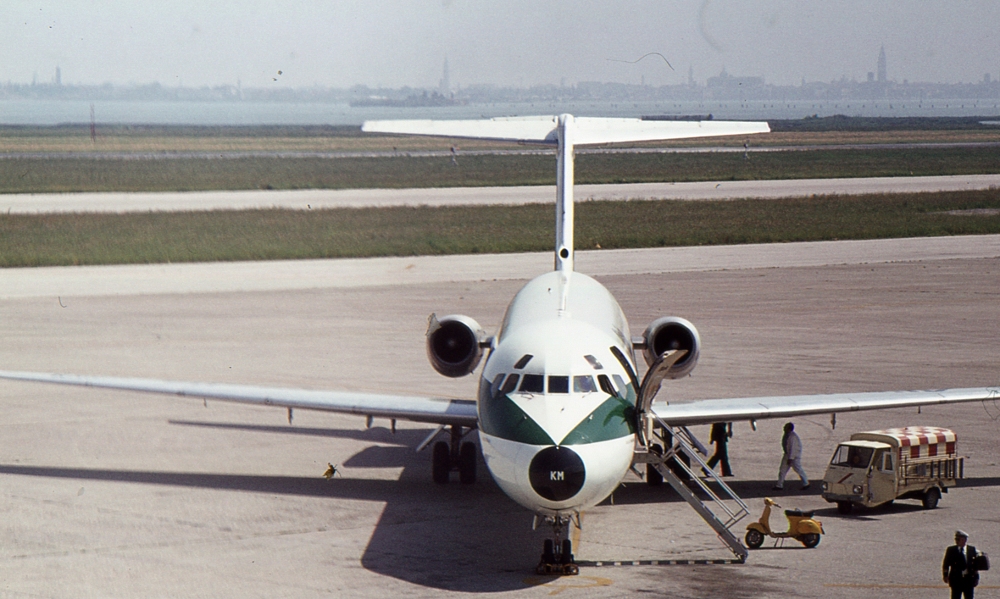
McDonnell Douglas DC-9-32, registration I-DIKM, built 1968, serial number 47224
Marco Polo (VCE), Venice, Italy, 21 May 1977

McDonnell Douglas DC-9-33RC, registration PH-DNR, built 1968, serial number 47279
location unknown, 1980s
DC-8 | DC-9 | DC-10 |
MD-11 | MD-80 |
MD-82 | MD-83 |
MD-87 | MD-90
McDonnell Douglas DC-10
The McDonnell Douglas DC-10 is a three-engine wide-body jet airliner. The DC-10 has range for medium- to long-haul flights, capable of carrying a maximum of 380 passengers. Its most distinguishing feature is the two turbofan engines mounted on underwing pylons and a third engine at the base of the vertical stabilizer. The model was a successor to McDonnell Douglas's DC-8 for long-range operations, and competed in the same markets as the Lockheed L-1011 TriStar, which has a similar layout. In its early years the DC-10 had a poor safety record; however, this has greatly improved over time. The DC-10 became McDonnell Douglas's first commercial airliner after the merger between McDonnell Aircraft Corporation and Douglas Aircraft Company in 1967. The first DC-10, a series 10, made its maiden flight on August 29, 1970. Production of the DC-10 ended in 1989.

McDonnell Douglas DC-10-30, registration PH-DTC, built 1972, serial number 46552
Schiphol (AMS), Amsterdam, Netherlands, 10 September 1974

McDonnell Douglas DC-10-40, registration N146US, built 1973, serial number 46755
Schiphol (AMS), Amsterdam, Netherlands, 12 July 1991
DC-8 | DC-9 | DC-10 |
MD-11 | MD-80 |
MD-82 | MD-83 |
MD-87 | MD-90
McDonnell Douglas MD-11
The McDonnell Douglas MD-11 is an American three-engine medium- to long-range wide-body jet airliner (after 1997 manufactured by Boeing Commercial Airplanes). Based on the DC-10, it features a stretched fuselage, increased wingspan with winglets, refined airfoils on the wing and smaller tailplane, new engines and increased use of composite materials. Two of its engines are mounted on underwing pylons and a third engine at the base of the vertical stabilizer. It also features a glass cockpit that decreases the flight deck crew from the three required on the DC-10 to two by eliminating the need for a flight engineer.
Although the MD-11 program was launched in 1986, McDonnell Douglas started to search for a DC-10 derivative as early as 1976. The last passenger MD-11 built was delivered to Sabena in April 1998.
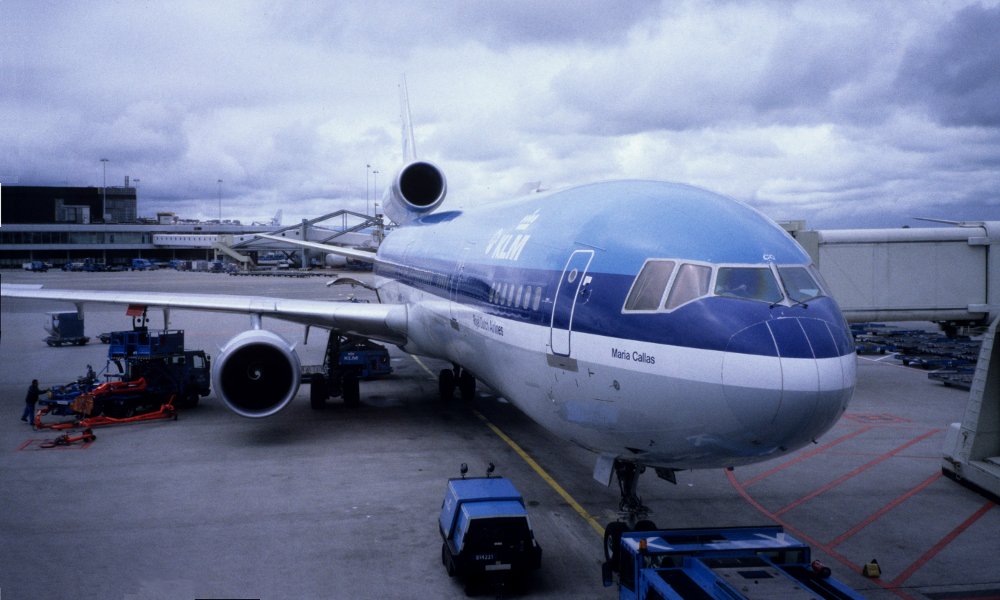
McDonnell Douglas MD-11, registration PH-KCG, built 1995, serial number 48561
Schiphol (AMS), Amsterdam, Netherlands, 17 July 2000
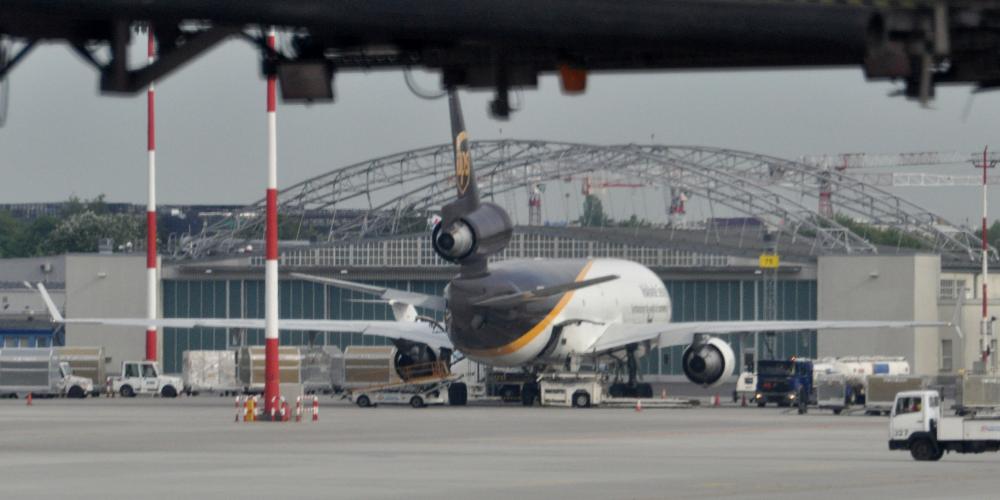

McDonnell Douglas MD-11F, registration N289UP, built 1991, serial number 48455
Warsaw Chopin Airport (WAW/EPWA), Warsaw, Poland, 16 June 2017
DC-8 | DC-9 | DC-10 |
MD-11 | MD-80 |
MD-82 | MD-83 |
MD-87 | MD-90
McDonnell Douglas MD-80
The McDonnell Douglas MD-80 is a series of twin-engine, short- to medium-range, single-aisle commercial jet airliners. It was lengthened and updated from the DC-9. This series includes the MD-81, MD-82, MD-83, MD-87 and MD-88 variants and can seat from 130 to 172 passengers depending on variant and seating configuration.
DC-8 | DC-9 | DC-10 |
MD-11 | MD-80 |
MD-82 | MD-83 |
MD-87 | MD-90
McDonnell Douglas MD-82
Announced on April 16, 1979, the MD-82 (DC-9-82) was a new MD-80 variant with similar dimensions to those of the MD-81 but equipped with more powerful engines. The MD-82 was intended for operation from 'hot and high' airports but also offered greater payload/range when in use at 'standard' airfields.[21] American Airlines is the world's largest operator of the MD-82, with at one point over 300 MD-82s in the fleet.
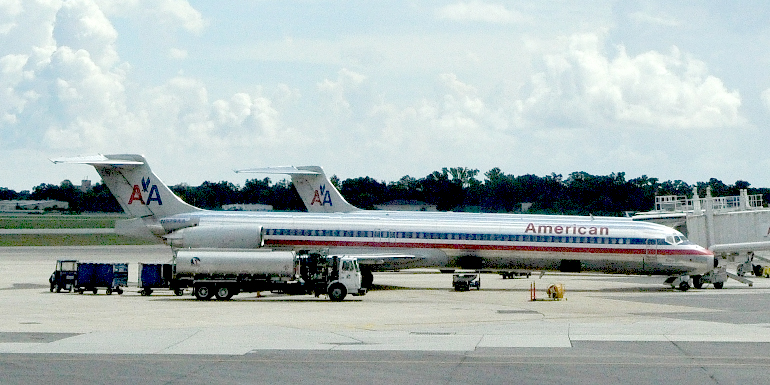
McDonnell Douglas MD-82, registration N579AA, built 1991, serial number 53156
Louis Armstrong New Orleans International Airport (MSY), New Orleans, LA, USA, 15 Augustus 2009
DC-8 | DC-9 | DC-10 |
MD-11 | MD-80 |
MD-82 | MD-83 |
MD-87 | MD-90
McDonnell Douglas MD-83
The MD-83 is a longer range version of the basic MD-81/82 with higher weights, more powerful engines, and increased fuel capacity.
First flight 17 December 1984, entry into service Februari 1985 and last delivery on 28 December 1999.

McDonnell Douglas MD-83, registration PK-OCR, built 1995, serial number 53452
Prambanan, Indonesia, 8 Augustus 2016
DC-8 | DC-9 | DC-10 |
MD-11 | MD-80 |
MD-82 | MD-83 |
MD-87 | MD-90
McDonnell Douglas MD-87
The McDonnell Douglas MD-87 is a shortened version of the successful MD-80 series. A reversal of the trend from the DC-9 to the MD-80 series, the MD-87 combines the advanced features introduced on the MD-80 (most notably the Pratt & Whitney JT8D-200 engines) into a 5.3m (17ft 5in) shorter length fuselage similar in length to the DC-9-30. The MD-87 features the 39.75m (130ft 5in) fuselage length; plus an EFIS flightdeck (the MD-87 was the first aircraft of the MD-80 series to introduce EFIS, with two flight management system controls, displays and cockpit) and an optional Sundstrand Head-Up Display; Pratt & Whitney JT8D-217C turbofans (which are approximately 2% more efficient than the 217A); the cruise performance package improvements introduced on late production MD-80s, including the extended low drag tail cone, fillet fairing between the engine pylons and the fuselage and low drag flap hinge fairings; and increased height fin to compensate for the loss of moment arm due to the shorter fuselage. The MD-87 was optionally available with extra front and rear cargo compartment auxiliary fuel tanks to extend range, and other engines in the JT8D-200 series. In other respects the MD-87 is essentially identical to the MD-80 series. McDonnell Douglas launched development of the MD-87 on January 3 1985, following the placement of launch orders from Finnair and Austrian in December 1984. First flight took place on December 4 1986 and US FAA certification was granted on October 21 1987. MD-87 sales were relatively small and mainly to traditional Douglas customers. Notable operators include Iberia (with 24), SAS (18) and Japan Air System (eight). Other operators include e.g. Finnair, Aero Lloyd, Aeromexico, Great American, Austrian, Spanair, Reno Air, and Midway. By the time Boeing and McDonnell Douglas had merged in 1997 all MD-87 orders had been fulfilled and Boeing no longer actively offers the type.
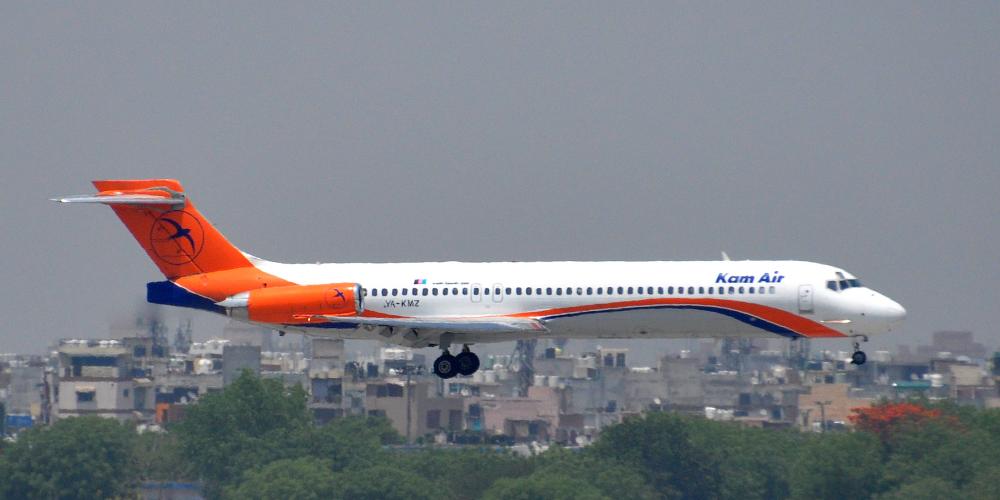

McDonnell Douglas MD-87 (DC-9-87), registration YA-KMZ, built 1991, serial number 53337
Indira Gandhi International Airport (DEL, VIDP), Delhi, India, 30 April 2018
DC-8 | DC-9 | DC-10 |
MD-11 | MD-80 |
MD-82 | MD-83 |
MD-87 | MD-90
McDonnell Douglas MD-90
The McDonnell Douglas MD-90 is a twin-engine, short- to medium-range, single-aisle commercial jet airliner. The MD-90 was developed from the MD-80 series. Differences from the MD-80 include more fuel-efficient International Aero Engines V2500 engines and a longer fuselage. The MD-90 has a seating capacity of up to 172 passengers and was introduced into service with Delta Air Lines in 1995.
The aircraft first flew on 22 February 1993 and the first MD-90 was delivered to Delta in February 1995. MD-90 production at Long Beach, California ended in 2000.
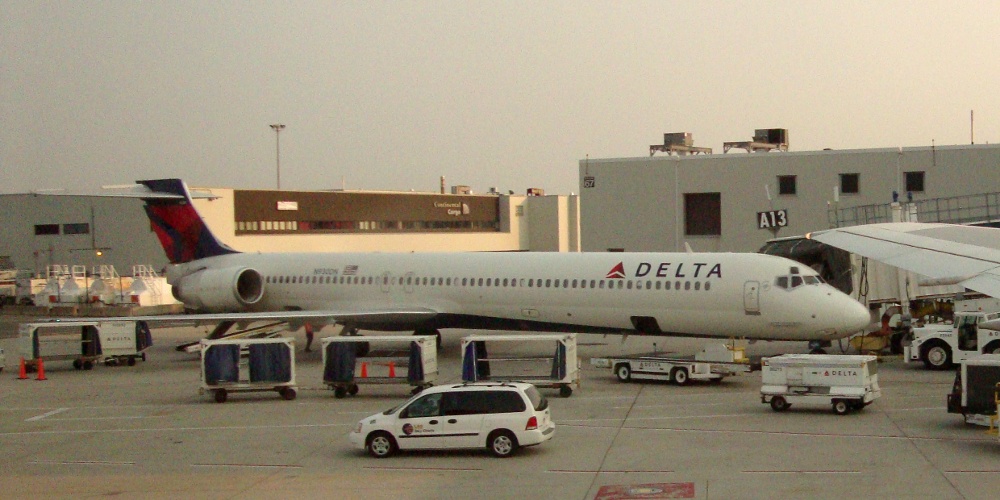
McDonnell Douglas MD-90-30, registration N930DN, built 1996, serial number 53458
Logan Airport (BOS), Boston, MA, USA, 18 August 2012
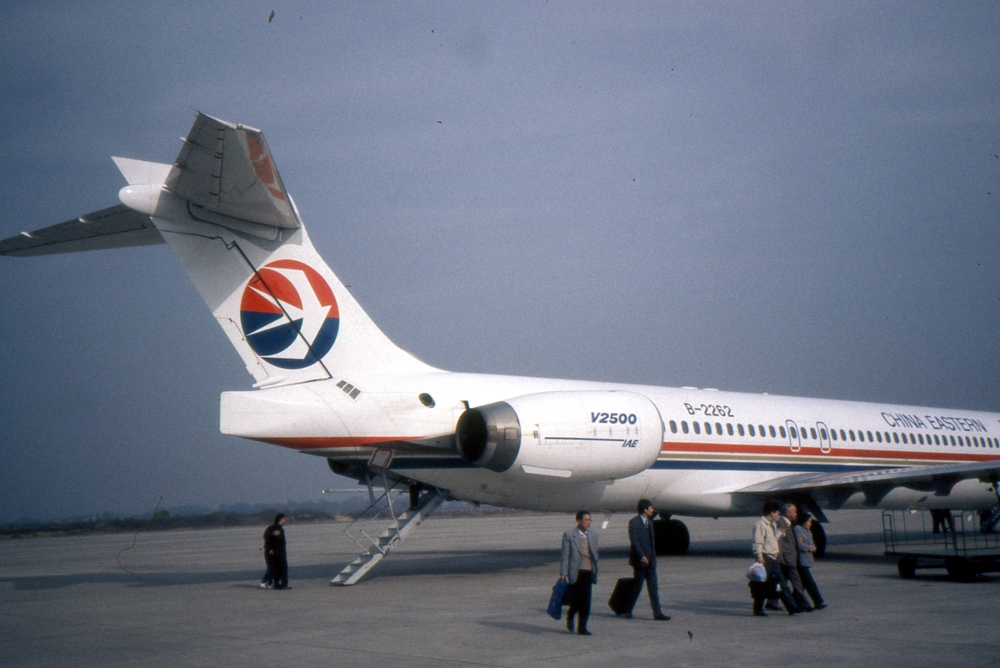
McDonnell Douglas MD-90-30, registration B-2262, built 1998, serial number 53585
Hefei Xinqiao International Airport (HFE), Hefei, Anhui, China, 21 November 1998
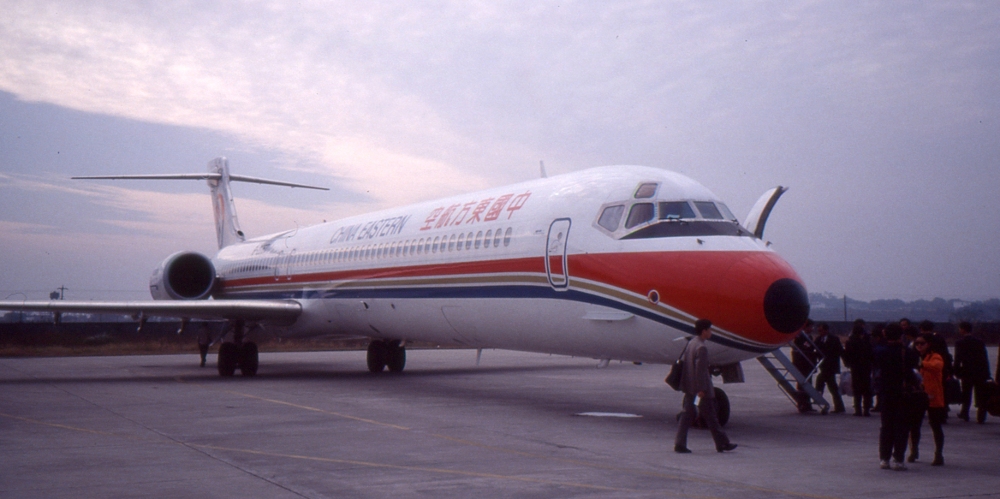
McDonnell Douglas MD-90-30, registration B-2257, built 1997, serial number 53583
Huang Shan Tunxi International Airport (TXN), Tunxi, Anhui, China, 23 November 1998
DC-8 | DC-9 | DC-10 |
MD-11 | MD-80 |
MD-82 | MD-83 |
MD-87 | MD-90
|
















